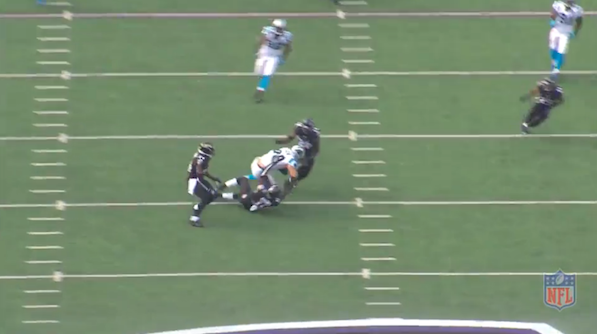When the Baltimore Ravens took on the Carolina Panthers Sunday, a pleasant surprise occurred when the active roster was released.
Rookie free safety Terrence Brooks – inactive for the Week 3 game against the Cleveland Browns – was active. For a secondary that struggled drive after drive against the Browns, adding Brooks back to the mix couldn’t hurt, and the results paid off.
Not only was the third-round pick active, but he took his first defensive snaps of his career, and plenty of them. Brooks was on the field for 34 of Baltimore’s 69 defensive snaps.
Outside of some poor plays by safeties Darian Stewart and Matt Elam, Baltimore’s secondary as a whole performed quite well against Cam Newton and Co.
Part of the reason for the success was Brooks’ presence on defense. The rookie received ample playing time, and during his time on the field, his versatility was on display, offering various coverage options for the defense.
Having Brooks on the field paved the way for Elam to play closer to the line of scrimmage – a more ideal scenario -, as Brooks was often either a center fielder or in Cover 2 with Stewart.
Brooks’ presence gave more freedom to defensive coordinator Dean Pees, and the safety’s play offered a welcomed addition to the Baltimore secondary.
After a positive debut, perhaps Brooks will become a fixture in Baltimore’s defense.
Why should he be active each week and on the field?
Let’s take a look.
Known for his coverage downfield and elite closing speed, Brooks was also used close to the line on Sunday.
Here, Brooks lines up in the box, similar to what Elam did often when Brooks was on the field.
With outside linebacker Elvis Dumervil blitzing, Brooks must pick up slot tight end Greg Olsen.
Brooks easily reacts to his coverage pickup, and as Olsen takes off downfield, the Ravens defender is already in position to run with the tight end.
As Olsen’s route develops down the seam, Brooks matches him stride for stride and takes him out of Newton’s receiving options.
Brooks has the hip fluidity and turn-and-go ability of a cornerback, so picking up slot receivers is no large task for number 31.
For the most part, however, Brooks was used as a deep safety. He was typically on the field in conjunction with Stewart and Elam, allowing Pees to get creative with the three safeties.
Brooks and Stewart are in Cover 2 with Elam playing up on the line.
Playing the deep half, Brooks’ main coverage occupation is keeping an eye on former Florida State teammate Kelvin Benjamin, the Panthers receiver on Brooks’ side of the field.
With Elam manning the underneath area, Brooks can focus on the back end.
Benjamin runs a post, which Brooks easily bites on and seals off.
Elam’s presence takes away Olsen as an option on the right side of the defense, and Brooks’ positioning overtop of Benjamin takes him away as well.
The Panthers still completed a pass on the play as a receiver broke lose underneath, however the coverage by Brooks and his ability to play safety and let Elam move forward is noticeable.
Occupying half of the field is nice, but can Brooks be relied on as the lone deep safety?
His performance on Sunday suggests just that.
Here, Elam and Stewart play close to the line as Brooks is on an island as a center fielder deep.
Playing about 20 yards away from the line of scrimmage, Brooks has plenty of ground to cover as he has to help out Stewart, who was unsuccessful at picking up Olsen heading down the middle of the field.
Olsen has barely snuck past Stewart, yet Brooks’ reaction time is noticeable as he has already begun his pursuit toward the tight end, who becomes an obvious pass-catching threat in the middle of the field.
The tight end catches the pass with about 10 yards of space between him and Brooks.
The large amount of open space in a one-on-one situation is a daunting task for a defender.
Brooks isn’t fazed by the problem he faces, and takes off toward Olsen full speed, squaring his body up in the process.
The end result is Brooks positioning himself in front of Olsen and taking him out by the legs while Elam jumps in to aid Brooks on the tackle, preventing the ball carrier from gaining anymore extra yardage after the catch.
For a safety in his NFL debut on defense, Brooks didn’t show many rookie mistakes.
His tackling was up to par, his reaction time was superb and his diverse skill set was on display.
Now with half a game of reps under his belt, it’s likely the Ravens will continue to work him into the line up more week by week.
It remains to be seen whether or not he can firmly grab a full-time role this season; the three-safety sets seem to work and Will Hill’s return in two weeks could reduce Brooks’ playing time.
But it was evident on Sunday that adding Brooks to the secondary rotation benefitted the defense.
We were wondering when Brooks would finally be inserted into the lineup. Perhaps from here on out he’ll be a regular in Baltimore’s secondary, and rightfully so.

















